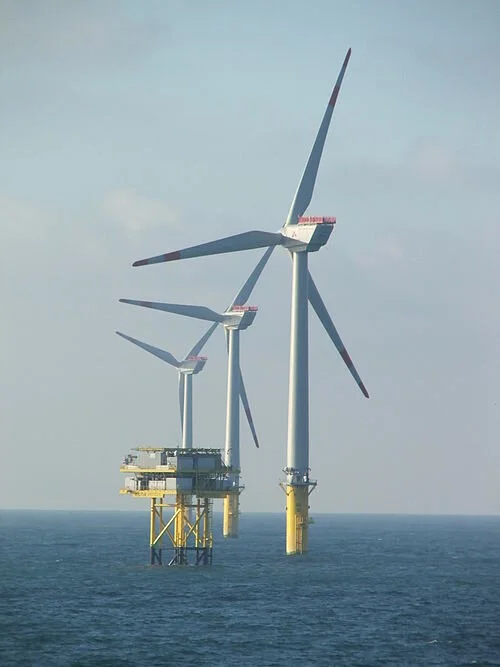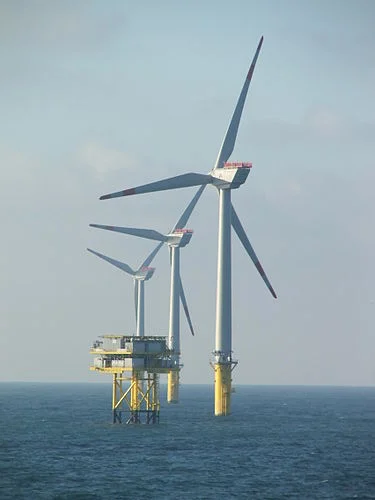Wind-farm configurations
From Robert Whitcomb’s “Digital Diary,’’ in GoLocal24.com
Predictability and standardization are generally sought by businesses, large and small. Thus it should be good news that five companies seeking to set up offshore wind-turbine farms off southern New England have agreed to a common layout for their projects: a standard east-west orientation, with each turbine a nautical mile apart. That’s mostly to try to satisfy fishermen, some of whom express the (exaggerated) fear that the wind farms would reduce their ability to maneuver.
The five companies are Vineyard Wind, Eversource Energy, Mayflower Wind, Orsted North America and Equinor Wind.
The Trump administration, in thrall to the Red State-based fossil-fuel industry, seems to be using some fishermen’s complaints as cover in trying to stop some big renewable-industry projects, which the regime, as with “green energy’’ projects in general, associates with Democrats.
An irony in all this is that the supports for turbine towers act as reefs that attract fish.
The long debate about offshore wind farms continues as signs rapidly multiply that global warming caused by burning oil, gas and coal is accelerating, along with the damage it’s doing, although most people are not yet concerned enough about the crisis to push for serious political and policy action to reverse it. Some of those actions would indeed be quite inconvenient.
Eversource to use drones to monitor infrastructure
From The New England Council (newenglandcouncil.com)
“Eversource Energy recently announced its plans to begin using drones to conduct inspections of high-voltage infrastructure. Eversource is a Hartford- and Boston-based utilities company that provides electricity for over a million customers throughout Connecticut, Massachusetts, and New Hampshire.
The energy company intends to implement drones to monitor 100 percent of its power line and electrical infrastructure maintenance. This high-tech solution has many benefits, some of which include minimizing the need for infrared helicopter inspections, cutting down on fossil fuel use, and obtaining a more frequent view of the electrical infrastructure to identify and prevent potential issues. Eversource has been experimenting with drone usage since 2016, but only decided recently to make piloting them routine. As the energy industry becomes increasingly aware of the affordability and practicality of inspection drones, it is likely Eversource will become just one company of many who are taking advantage of this technology.
Carol Burke, Eversource Energy’s manager of transmission line operations in New Hampshire, said, “At first, we really were just targeting specific lines that we knew might have some issues. It worked out great and in the last two years we ended up developing a more formal program. It’s a great way to do an inspection as with very clear, detailed videos and pictures you can see any type of defect, aging or rotting on a structure.”
Tim Faulkner: Will hurricanes imperil wind turbines off the Northeast?
Via ecoRI.org
As new offshore wind farms are built off the Northeast coast, a new report suggests that the current models of wind turbines may not withstand the most powerful of hurricanes. The study, by the University of Colorado Boulder, the National Center for Atmospheric Research and the U.S. Department of Energy, is intended to help the budding offshore wind industry as it expands into hurricane-prone regions, such as the East Coast.
“We wanted to understand the worst-case scenario for offshore wind turbines, and for hurricanes, that’s a Category 5,” said Rochelle Worsnop, lead author and a graduate researcher in the University of Colorado's Department of Atmospheric and Oceanic Sciences (ATOC).
Current design standards require offshore wind turbines be built to withstand 112-mph winds. Using computer-generated simulations, researchers found that portions of Category 5 hurricanes can reach up to 200 mph. Turbine blades also can be stressed by sudden and powerful shifts in wind direction, called veer.
Offshore wind turbines are typically larger than land-based turbines because components can be shipped over water instead of along size-restrictive railways and roads. The structures are therefore exposed to greater harm over their 20- to 30-year life, according to the report.
“Success could mean either building turbines that can survive these extreme conditions, or by understanding the overall risk so that risks can be mitigated, perhaps with financial instruments like insurance,” said Julie Lundquist, a co-author of the study and a professor at ATOC and the Renewable and Sustainable Energy Institute.
A subsequent study by the same group will look at the long-term effects of hurricanes on offshore wind farms built off the Atlantic Coast.
Rhode Island holds the honor of building the country’s first offshore wind farm, with the completion of the Block Island Wind Farm last November. The developer of the five-turbine, 30-megawatt wind farm, Providence-based Deepwater Wind, says the University of Colorado study is more relevant to the Southeast, where hurricane are more common and more powerful.
“Current offshore wind turbine designs are suitable for the wind conditions expected in the Northeast, where the strongest hurricane to make landfall in recorded history was a Category 3," Deepwater Wind spokeswoman Meaghan Wims said.
The most recent Category 3 hurricane to make landfall in New England was Hurricane Carol on Aug. 31, 1954. The storm had a sustained wind of 110 mph.
Deepwater Wind designs its turbines to withstand a 100-year storm, which has top wind speeds of 134 mph.
In the coming the decades, the company is planning to erect wind farms in the waters between Maryland and Maine.
“We don’t expect offshore wind energy to be deployed in the Southeast in the near term for other reasons — namely, a lower offshore wind resource than the Northeast,” Wims said.
Deepwater Wind and other developers have proposed multiple projects off of the wind-rich Northeast coast. Deepwater Wind is advancing a 15-turbine project, called South Fork Wind Farm, off eastern Long Island. Its Deepwater ONE project is slated for thousands of acres of federal waters between Massachusetts and Rhode Island. Vineyard Wind and DONG Energy, both based in Denmark, are also planning projects in the region. Bay State Wind, owned by DONG and Eversource Energy, intends to build several wind farms in the region.
But it’s only a matter of time before these wind turbines are tested by hurricanes. A report by the Union of Concerned Scientists says climate change, and warming oceans in particular, are making coastal storms more intense. Since the 1970s, the number of Category 4 and 5 hurricanes has almost doubled. Category 5 hurricanes have winds exceeding 157 mph; Category 4 winds blow between 130 and 156 mph; Category 3 winds are between 111 and 129 mph.
Tim Faulkner writes for ecoRI News.




